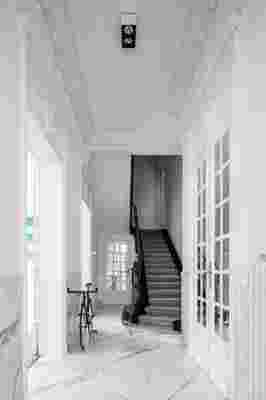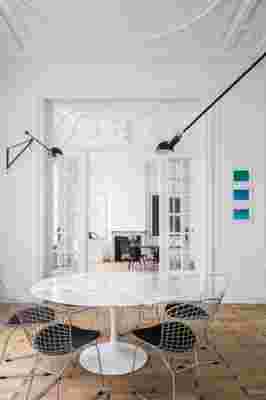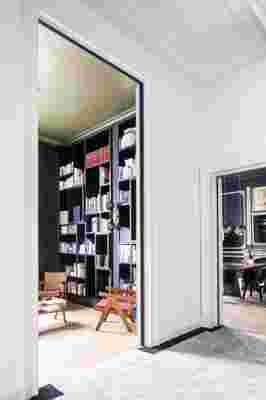It took six months of renovations to transform a storied building in Brussels into the modernized townhouse that Ronald Rozenbaum calls home. He debuted the finished product by inviting some visitors over for a first look at the fresh interiors—but a typical housewarming party wouldn’t do for this unique space. Instead, Rozenbaum, an established Belgian art collector, opened up his home to the public, welcoming friends and strangers alike to experience an inaugural exhibition assembled in the newly opened art gallery on the lower level.
Rozenbaum had fallen for the property at first sight and immediately began dreaming up a way to capitalize on its 10,000-square-foot-plus footprint. “I knew right away it would be too much space for day-to-day life, which allowed us to start getting creative with other uses,” he says. The collector called up his old friend Julie Engels, the founder and owner of Brussels-based architecture firm Studio P Architects, enlisting her help in bringing his art-centric vision to life.
Marks of the past were littered throughout when Engels took on the project. The dilapidated house, built in 1910, was previously a hotel and then operated as a Lebanese embassy for 30 years before Rozenbaum snatched it up. He remembers the sad state of it when he first visited: “Communist-era offices with peeling, patterned wallpaper and busts of bygone leaders stashed in the attic.” Happily, with Engels’s sharp eye for design, the pair were able to identify several salvageable aspects amid the decay.

Slabs of restored “Michelangelo marble,” so nicknamed due to the artist’s affinity for it in his sculpting, line the floor and walls in the home’s grand entry hall. They were just one of many surprises uncovered during the renovations.
Engels devised a plan to reconfigure the enormous house without glossing over its previous identities—carefully maintaining historic attributes like the intricate crown moldings, patterned parquet floors, and marble-flanked entrance hall. She carved out a sensible, scaled-down living space for Rozenbaum and his partner, Elena Soboleva, on the first and second floors, leaving the lower level open to serve as an office and periodic artist’s residency personally curated by the couple. In a reverent nod to the past, Rozenbaum dubbed his gallery space “The Embassy.”
“We needed to respect and emphasize the historic structure of the house,” explains Rozenbaum. Fortunately, the long-hidden beauty uncovered during the renovations brings what he calls “a poetic intimacy” to the space, making it even more suitable for displaying his eclectic collection. “It looked like the house had been in hibernation for years,” says Engels. “We gave her a very respectful facelift, keeping it in its magnificent architectural language while bringing it up to date.”


RELATED: An Antique-Filled Fifth Avenue Apartment That’s a Transatlantic Affair
